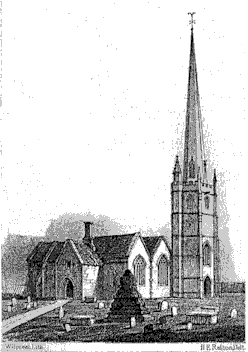St Mary Magdalen Church, Tetbury
 The old church, illustrated to the
right, was demolished in 1777, with the exception of the tower and spire.
The old church, illustrated to the
right, was demolished in 1777, with the exception of the tower and spire.
The church is purported to have been founded in 1160, but the tower and spire dates from around 1400.
The old church had an aisle on the south side, and two aisles on the
north side; at the west end of each of which were windows of five lights, with quatrefoil
tracery above.
There was a central chancel with a rood loft, and two side chancels on the north and south
sides. Under the arch parting the south aisle from the chancel was the monument of the
great William de Braose, lying cross-legged in his coat of mail, his sword by his side, and
a lion at his feet, noted emblems of his having been engaged in the Crusades.
On the south side was a porch, over which was a room in which the Grammar School was formerly kept. There was a chapel on the left hand entering the church, in which "was a fair wall piece, and lively effigy of John Savage, Gent., in his sable robes, kneeling."
In the north aisle was a statue monument to one of the Gastrells. There was a small vestry on the north side of the chancel.
New Church
Building of the new church at the same location commenced in 1777 and, incorporated the tower and spire from the old church. The architect was Francis Horne of Warwick, and it was opened for divine service on the 7th October, 1781.
The chancel is very short, and is raised by two steps above the body of the church. On the north side is a handsome marble monument to the memory of Sir William Romney, with his effigy above, erected at the expense of the Rev. John Wight; and on the south side, a somewhat similar one to the Rev. John Savage, late Rector of Beverstone.
Over the altar (which is of mahogany), is a picture representing the Holy Family. The east window is very lofty, and of five lights, with curiously elaborated tracery. The altar rails are also of mahogany. The pulpit, reading desk and font, (which is of very small and mean proportions) are in front of the altar.
The church is pewed throughout, the entrance to the side pews are from doors in the north and south cloisters. Each door gives an entrance to five pews, thus making the collection of alms by the Churchwardens a long and somewhat difficult process.
The east wall of the church, over the vestry and south doors, is covered with monuments, erected to the memory of different families connected with the town.
The organ is in a gallery at the west end, and there are also galleries extending half way along the north and south walls of the church.
There are seven large and very lofty windows of four light each on either side of the church, with tracery similar to that of the east windows.
The vestry is on the south side of the chancel.
The two town chests are kept one in the north, the other in the south cloister.
The interior dimensions of the church are as follows:-
Extreme length from north to south 120 feet.
Extreme width, including the cloisters 62 feet.
Height from the floor to the ceiling 42 feet.
Height of spire, from ground to the
top of the head of the weathercock 186 feet.
[The spire is purported to be the fourth highest in England.]
In the tower there is a fine ring of eight bells. Seven were placed there in 1722. On them are the following inscriptions cast round the rim :-
1st and 2nd. Prosperity to the Church of England.
3rd. Prosperity to this Town.
4th Prosperity to this Town and Parish.
5th and 6th. Giles Body, Matthew Wilkins, ChXwardens.
7th. I, to the church the living call, and to the dead do summons all.
In the centre of the inscription on all the bells is the date 1722, and the initials A.R.
[There can be little doubt that these initials are those of Abraham Rudhall, a celebrated bell-founder of Gloucester.]
The eighth bell was erected in 1803; on it is the following inscription ;
8th. J. Rich and R.M. Warman, C.W., 1803. J.Rudhall, fecit.
There are also a set of chimes in the tower, which were given by the Rev. John Wight, in 1749; they play the tune of the 113th Psalm for about four minutes every four hours, viz. at ten, two, and six.
Illustration and description from "The History of the Town and Parish of Tetbury", by Rev. Alfred T. Lee, published in 1857.
